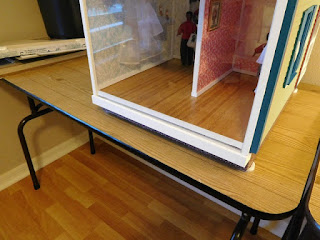The unique architectural design of this dollhouse, with its angled roof eaves, presented a challenge for creating a back cover. However, a creative solution was developed to address this issue. The dollhouse's straight angles and even back walls allowed for a single panel back cover that could completely conceal the interior. The design involved a simple yet effective mounting system using a bottom rail and a magnetic top attachment.
To create the perfect fit, a template was first made using copy paper, then transferred to poster board. This method ensures accuracy, as dollhouses are rarely perfectly square. A careful dry fit confirmed the template's precision, particularly at the roof's apex. Strong neodymium magnets were crucial for the top attachment. One magnet was securely glued to the roof's apex using crazy glue to ensure a firm hold. A wooden rail was installed along the bottom floor to support the panel's lower edge.
An acetate poster frame panel proved to be the ideal material for the back cover. Unlike hardware store acrylic, this panel could be easily cut with a craft knife and was lightweight. To improve stability and appearance, the panel's sides were framed with strip wood. A wooden peg with an attached magnet was created as a pull mechanism, allowing easy removal of the panel. When in place, the panel rests on the bottom rail and is held securely by the top magnet.
The design allows for simple access to the dollhouse interior while maintaining a clean, finished look. Care must be taken when handling the acetate panel, as it can scratch easily. Cleaning should be done only with a microfiber cloth, and minimal handling is recommended.








